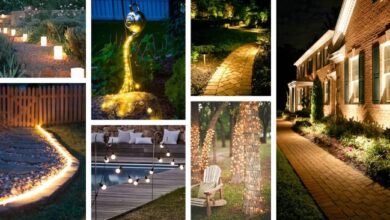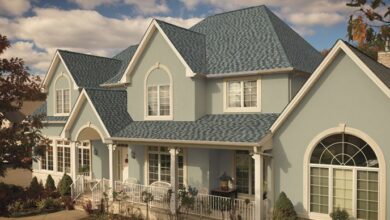Smart Home Lighting Systems A Comprehensive Guide
Smart home lighting systems are transforming how we illuminate and interact with our living spaces. From simple energy-saving features to complex automation and integration with other smart home devices, these systems offer unparalleled convenience and customization. This guide delves into the various types of smart lighting available, exploring their installation, control, and the potential security and privacy considerations. We’ll also examine the energy efficiency benefits and exciting future trends shaping this rapidly evolving technology.
This exploration covers the diverse landscape of smart lighting, from the technological underpinnings of LED, incandescent, and halogen bulbs to the user-friendly interfaces and advanced automation capabilities offered by leading brands like Philips Hue, LIFX, and Kasa. We will provide practical guidance on installation, troubleshooting, and maximizing the potential of these systems to create a truly personalized and efficient home environment.
Types of Smart Home Lighting Systems
Smart home lighting systems offer a convenient and customizable way to control your home’s illumination, enhancing both ambiance and energy efficiency. These systems utilize various technologies and offer a range of features, allowing homeowners to choose the best option to suit their needs and budget. Understanding the different types and their capabilities is crucial for making an informed decision.
Smart Lighting Technologies
Smart lighting systems primarily utilize LED (Light Emitting Diode) technology due to its energy efficiency, long lifespan, and compatibility with smart home integration. While incandescent and halogen bulbs can be incorporated into some systems using smart plugs, LEDs are the dominant choice for their inherent advantages in smart home applications. LEDs offer precise color control and dimming capabilities, essential features for creating dynamic lighting scenarios.
Incandescent bulbs, while readily available, are less energy-efficient and have shorter lifespans, making them less suitable for extensive smart home integration. Halogen bulbs, while more efficient than incandescent, still consume more energy than LEDs and generate more heat.
Comparison of Smart Lighting Systems
Several prominent brands offer comprehensive smart lighting systems, each with its unique features and price points. Consider factors such as the range of supported bulbs, integration with other smart home ecosystems, and the level of control offered when choosing a system.
| System Name | Technology Used | Key Features | Price Range |
|---|---|---|---|
| Philips Hue | LED | Wide range of bulb types and accessories, extensive color options, robust app control, integration with various smart home platforms (Apple HomeKit, Google Home, Amazon Alexa). | $50 – $500+ (depending on the number of bulbs and accessories) |
| LIFX | LED | Wi-Fi enabled bulbs, no need for a separate hub, wide color range, good app control, integrates with various smart home platforms. | $30 – $100+ (per bulb) |
| Kasa Smart | LED (mostly) | More affordable option, requires a smart plug for non-smart bulbs, basic color control, integrates with Amazon Alexa and Google Home. | $10 – $50+ (per bulb or plug) |
Smart Home Lighting System Setup and Installation
Setting up a smart home lighting system can seem daunting, but with a methodical approach, it’s a straightforward process. This section details the steps involved in installing a basic system, connecting lights to your Wi-Fi, and configuring various smart bulb and switch types. Remember to always consult the manufacturer’s instructions for your specific devices, as processes can vary slightly.
Smart home lighting systems offer unparalleled convenience and ambiance control, enhancing any living space. The right lighting can truly elevate a room’s aesthetic, complementing, for example, the exquisite craftsmanship found in pieces from High-end furniture collections. Ultimately, thoughtful lighting choices, whether automated or manual, are crucial in showcasing the beauty and detail of your home furnishings.
Successful smart lighting installation hinges on understanding your home’s existing electrical setup and the capabilities of your chosen smart devices. Factors such as the type of light fixtures, the presence of neutral wires, and your home’s Wi-Fi strength all play a role in the ease and success of the installation.
Smart home lighting systems offer incredible convenience and ambiance control, enhancing any living space. However, maximizing the benefits often requires thoughtful organization, especially in smaller homes. This is where clever solutions, such as those found on this helpful resource for Small space storage solutions , become invaluable. By decluttering and optimizing storage, you can better showcase your smart lighting and create a truly cohesive and functional environment.
Installing a Basic Smart Lighting System
Installing a basic system typically involves replacing existing light bulbs with smart bulbs or adding smart switches to control existing fixtures. For a smart bulb installation, the process is relatively simple: unscrew the old bulb, screw in the new smart bulb, and then connect it to your Wi-Fi network using a smartphone app. Smart switches, on the other hand, require some basic electrical knowledge and may necessitate turning off the power to the circuit before installation.
Consider the following illustrative example: Replacing a standard incandescent bulb in a table lamp with a Philips Hue smart bulb. First, ensure the power to the lamp is off. Next, unscrew the old bulb and carefully screw in the new Hue bulb. Then, download the Philips Hue app, create an account, and follow the app’s instructions to connect the bulb to your home Wi-Fi network.
The app will guide you through the process of adding the bulb to your system and assigning it to a room or zone. Once connected, you can control the bulb’s brightness, color, and on/off state via the app.
Connecting Smart Lights to a Home Wi-Fi Network
Connecting smart lights to your Wi-Fi network is crucial for remote control and automation. Most smart bulbs and switches use your home’s Wi-Fi network to communicate with a central hub or directly with a smartphone app. The process typically involves downloading a dedicated app from the manufacturer, creating an account, and following the in-app instructions. These instructions usually involve placing the smart device within range of your Wi-Fi router, entering your Wi-Fi password, and confirming the connection.
Some systems utilize Bluetooth for initial setup, before switching to Wi-Fi for regular operation.
Smart home lighting systems offer unparalleled control and convenience, enhancing any space. Extending this control to your outdoor areas is simple, especially when considering the aesthetic possibilities offered by Summer outdoor living decor , which can be beautifully highlighted with strategically placed smart lights. Imagine setting the perfect ambiance for summer evenings with a tap on your phone; the possibilities for customized lighting schemes are endless.
For example, let’s imagine setting up a LIFX smart bulb. After screwing the bulb into the fixture, you’d launch the LIFX app, create an account (if necessary), and then the app will guide you to add the bulb to your Wi-Fi network by prompting you to enter your network’s SSID and password. The app will then communicate with the bulb to establish the connection.
The app often displays a visual indicator showing the connection status, and you’ll receive a notification upon successful completion.
Setting Up Different Types of Smart Bulbs and Switches
The setup process varies slightly depending on the type of smart lighting device. Smart bulbs, generally, are easier to install as they simply replace existing bulbs. Smart switches, however, require wiring into your existing electrical system, often needing to connect to a neutral wire for proper operation. Always turn off the power to the circuit before working with any electrical wiring.
For instance, setting up a Lutron Caseta smart dimmer switch involves turning off the power at the breaker box, removing the old switch, and carefully wiring the new Caseta switch according to the wiring diagram provided. The process requires matching the wires from the old switch to the corresponding terminals on the new switch. After connecting the wires, the switch is mounted in the wall, power is restored, and the switch is then added to the Lutron app, following the app’s instructions for connecting to the Wi-Fi network and integrating with other Lutron devices.
Smart Home Lighting System Control and Automation
Smart home lighting systems offer a level of convenience and control far beyond traditional lighting. The ability to automate lighting based on schedules, occupancy, or even other smart home devices transforms your home into a truly responsive and personalized environment. This section explores the various methods for controlling and automating your smart lighting setup.Controlling your smart lighting is remarkably intuitive and adaptable to your lifestyle.
Several methods provide seamless integration into your daily routine, offering a variety of options to suit individual preferences.
Methods of Controlling Smart Lighting
Smart home lighting systems offer diverse control options. Smartphone applications provide comprehensive control, allowing users to adjust brightness, color temperature, and create scenes remotely. Voice assistants, such as Amazon Alexa and Google Assistant, enable hands-free control through simple voice commands. Dedicated smart home hubs, like those from Samsung SmartThings or Apple HomeKit, act as central control points, allowing for coordinated management of multiple smart devices, including lighting.
Many systems also incorporate physical wall switches or dimmers that retain traditional functionality while integrating with the smart system.
Creating Automated Lighting Schedules and Scenes
Scheduling and scene creation significantly enhance the convenience and ambiance of smart lighting. Most platforms allow users to set schedules to automatically turn lights on and off at specific times, mimicking occupancy patterns or providing a sense of security when away from home. For instance, lights can be programmed to turn on at sunset and off at sunrise, adjusting automatically with seasonal changes.
Scenes allow users to save specific lighting configurations—combining color, brightness, and individual light settings—for various moods or activities. A “movie night” scene might dim the lights and adjust color temperature to a warm setting, while a “party” scene could brighten the lights and add dynamic color changes. The ease of setting up and modifying these schedules and scenes varies slightly between platforms but generally involves a user-friendly interface within the respective smartphone app.
Integrating Smart Lighting with Other Smart Home Devices
The true power of smart lighting lies in its integration with other smart home devices, creating a cohesive and responsive ecosystem. This integration enables automation beyond simple scheduling and creates truly personalized home experiences.
- Security Systems: Smart lighting can integrate with security systems to trigger lights upon detecting motion or intrusion, deterring potential intruders. For example, lights could automatically illuminate upon detecting motion in the backyard at night.
- Thermostats: Smart lighting can be integrated with smart thermostats to adjust lighting based on occupancy and temperature. Lights might dim when the thermostat detects no one is home and the temperature is set to low, conserving energy.
- Sensors: Motion sensors can automatically turn lights on when motion is detected in a specific area, offering convenience and energy efficiency. Similarly, door/window sensors can trigger lights when a door or window opens, enhancing security.
- Voice Assistants: Voice assistants like Alexa or Google Assistant allow hands-free control of lighting, enabling users to adjust settings or create scenes through voice commands.
Energy Efficiency and Cost Savings of Smart Home Lighting Systems
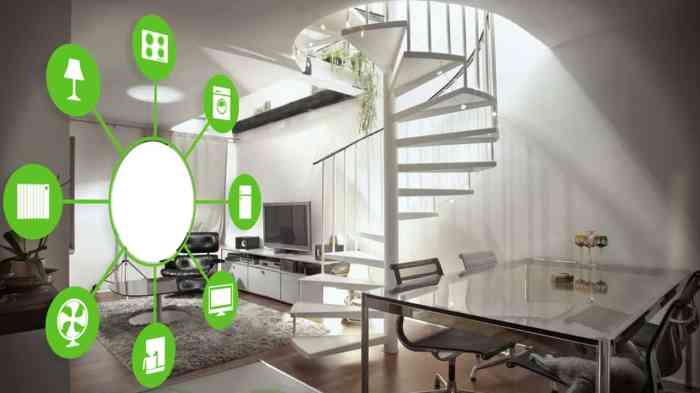
Source: einteractiveinc.com
Smart home lighting systems offer significant advantages beyond convenience and aesthetics. Their inherent energy-saving features can lead to substantial reductions in electricity bills and a smaller carbon footprint. This section details how these systems achieve energy efficiency and the potential cost savings they offer.Smart lighting systems achieve energy savings through several key features. Firstly, many smart bulbs utilize LED technology, inherently more energy-efficient than traditional incandescent or even CFL bulbs.
Secondly, smart systems allow for precise control over lighting, enabling users to only illuminate areas in use and only when needed. Features like scheduling and automation further enhance energy efficiency by automatically turning lights off when rooms are unoccupied or during periods of inactivity. Finally, many systems offer dimming capabilities, allowing users to reduce light intensity when full brightness isn’t necessary, leading to further energy savings.
Comparison of Energy Consumption
Smart LED bulbs typically consume significantly less energy than traditional incandescent or even CFL bulbs. For example, a 60-watt incandescent bulb can be replaced with a 9-watt LED smart bulb providing comparable brightness. This represents a reduction of over 80% in energy consumption. The energy savings become even more pronounced when considering the automated switching and dimming capabilities of smart lighting systems.
A home utilizing smart lighting, with automated schedules and occupancy sensors, can drastically reduce its overall energy consumption for lighting compared to a home relying solely on traditional lighting methods. This difference translates directly into lower electricity bills.
Smart home lighting systems offer incredible control over your home’s ambiance, allowing you to perfectly set the mood for any occasion. For the holidays, consider how lighting can enhance your festive décor; check out these Holiday mantel decorating tips for inspiration on creating a visually stunning fireplace mantelpiece. Then, use your smart lighting to subtly highlight key elements, creating a warm and inviting atmosphere throughout your home.
Potential Cost Savings
The following table illustrates the potential annual cost savings achievable by switching to a smart lighting system. These figures are based on estimates and will vary depending on factors such as electricity prices, the number of lights replaced, and usage patterns. However, they provide a reasonable illustration of the potential financial benefits.
| Lighting Type | Average Wattage per Bulb | Number of Bulbs | Daily Usage (hours) | Electricity Price ($/kWh) | Annual Cost ($) |
|---|---|---|---|---|---|
| Incandescent | 60W | 10 | 4 | 0.15 | 131.40 |
| Smart LED | 9W | 10 | 4 | 0.15 | 24.35 |
This table demonstrates a potential annual saving of $107.05 by switching from incandescent to smart LED lighting in a hypothetical scenario with ten bulbs used for four hours daily. In reality, savings can be even greater due to the smart system’s ability to automate and reduce usage further. For example, a family leaving for vacation could program their smart lights to turn off automatically, eliminating unnecessary energy consumption during their absence.
Smart home lighting systems offer significant convenience, allowing for customized illumination schemes. However, their sustainability is crucial; choosing energy-efficient LEDs is a key step. This aligns perfectly with the principles of Sustainable home decor , which emphasizes responsible material choices and reduced environmental impact. Ultimately, integrating smart lighting into a sustainable home enhances both comfort and eco-consciousness.
This type of automated control significantly enhances the cost-saving potential beyond simply replacing bulbs with more efficient alternatives.
Security and Privacy Considerations of Smart Home Lighting Systems
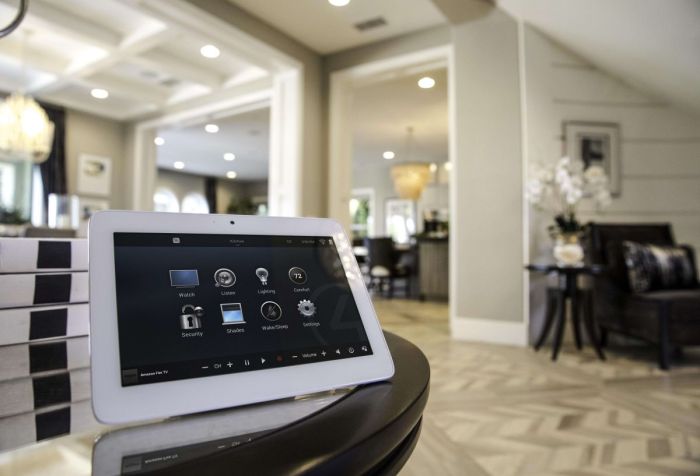
Source: cloudfront.net
Smart home lighting systems, while offering convenience and energy efficiency, introduce potential security and privacy vulnerabilities that users must understand and mitigate. These systems connect to your home network and, in many cases, the internet, creating entry points for malicious actors. Understanding these risks and implementing appropriate security measures is crucial for protecting your home and personal information.Smart home lighting systems are susceptible to various security threats, primarily stemming from network vulnerabilities and weak security practices.
These vulnerabilities can range from unauthorized access to your lighting system, potentially allowing control of your lights from afar, to more serious breaches that could compromise your entire home network. This could lead to data theft, identity theft, or even physical harm.
Network Vulnerabilities and Unauthorized Access
Weak or default passwords, unpatched software, and unsecured Wi-Fi networks are common entry points for hackers. For example, if a smart bulb uses a default password, any individual with knowledge of the system’s default credentials could gain control. Similarly, a poorly secured Wi-Fi network could allow access to not only the smart lighting system but also other connected devices in your home.
This highlights the importance of strong, unique passwords and regularly updating the firmware of all smart devices. Using a robust, password-protected router is also essential.
Data Privacy Concerns
Many smart lighting systems collect data about usage patterns, including when lights are turned on and off, their brightness levels, and even potentially location data if the system uses geolocation features. This data, if not properly secured, could be accessed by unauthorized individuals or companies, potentially leading to privacy violations. It’s crucial to understand what data your system collects, how it’s used, and what security measures are in place to protect it.
Reviewing the privacy policies of your smart lighting system and its manufacturer is essential.
Best Practices for Securing Smart Lighting Systems and Protecting User Privacy
Implementing strong security practices is paramount to minimizing risks. This involves using strong, unique passwords for each device and account, regularly updating firmware to patch security vulnerabilities, and utilizing a secure home network with strong encryption (WPA2/WPA3). Consider using a virtual private network (VPN) to add an extra layer of security, especially when accessing your smart lighting system remotely.
Additionally, limiting the number of devices connected to your home network can reduce the potential attack surface. Enabling two-factor authentication whenever possible further enhances security. Regularly reviewing your smart home system’s security settings and updating your router’s firmware are also important steps.
Importance of Strong Passwords and Regular Software Updates, Smart home lighting systems
Strong passwords are the first line of defense against unauthorized access. Avoid using easily guessable passwords and instead opt for complex passwords that include a combination of uppercase and lowercase letters, numbers, and symbols. Regularly updating the software on your smart lighting system and router is crucial for patching security vulnerabilities that could be exploited by hackers. Manufacturers frequently release updates that address known security flaws; neglecting these updates significantly increases your risk.
Consider enabling automatic updates to ensure your system remains up-to-date with the latest security patches.
Troubleshooting Common Smart Home Lighting System Issues
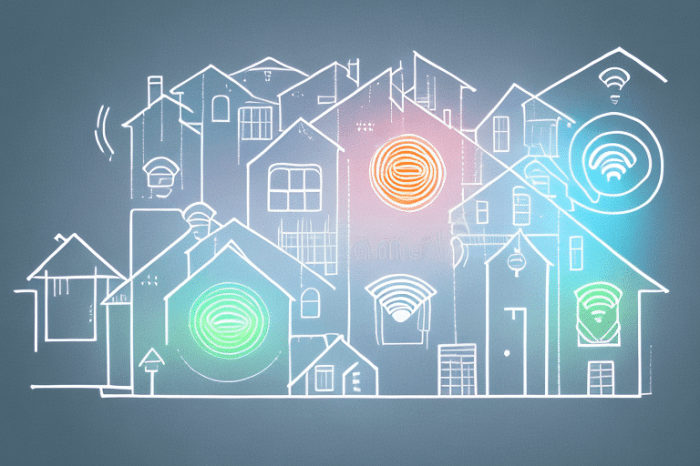
Source: dumbswitches.com
Smart home lighting systems, while convenient and energy-efficient, can occasionally present challenges. Understanding common problems and their solutions can significantly improve your user experience and minimize frustration. This section Artikels troubleshooting steps for connectivity issues, unresponsive lights, and malfunctioning switches, along with a helpful flowchart to guide you through the process.
Connectivity Issues
Connectivity problems are frequently the source of smart lighting malfunctions. These issues often stem from network instability, incorrect device pairing, or router limitations. Addressing these issues involves checking your home Wi-Fi network’s strength and stability, ensuring your smart bulbs and switches are correctly connected to your network, and verifying compatibility between your devices and your router. If using a mesh network, ensure the affected lights are within range of a strong node.
Restarting your router and smart lighting devices can also resolve temporary connectivity glitches. Finally, checking for firmware updates on both your router and smart lighting devices can often resolve compatibility issues and improve overall performance.
Unresponsive Lights
If your smart lights are unresponsive to commands from your app or voice assistant, several factors could be at play. First, confirm that the light is receiving power. A simple check of the bulb or switch’s power supply can quickly eliminate this possibility. Next, verify the light is still connected to your Wi-Fi network. If disconnected, attempt re-pairing the device.
If the light is still unresponsive, it might be experiencing a software glitch. A factory reset, detailed below, can usually remedy this. Lastly, check for interference from other electronic devices, particularly those operating on the 2.4 GHz frequency band, which is commonly used by smart home devices.
Malfunctioning Switches
Smart switches, while convenient, can occasionally malfunction. Similar to unresponsive lights, power supply issues should be checked first. If the switch is receiving power, verify that it is properly wired and correctly configured within your smart home system. Incorrect wiring can lead to inconsistent functionality. If the switch is still unresponsive after verifying wiring and power, a factory reset might be necessary.
In some cases, a faulty switch might require replacement, especially if the issue persists after troubleshooting.
Troubleshooting Flowchart
A visual flowchart can streamline the troubleshooting process. Imagine a flowchart with the following branching points:
- Problem: Light unresponsive. Branch to: Is the light receiving power? Yes/No. If No, check power source. If Yes, proceed.
- Problem: Light unresponsive (power confirmed). Branch to: Is the light connected to Wi-Fi? Yes/No. If No, re-pair the device. If Yes, proceed.
- Problem: Light unresponsive (power and Wi-Fi confirmed). Branch to: Try a factory reset. If unsuccessful, contact manufacturer support.
- Problem: Switch unresponsive. Branch to: Is the switch receiving power? Yes/No. If No, check power source. If Yes, proceed.
- Problem: Switch unresponsive (power confirmed). Branch to: Check wiring and configuration. If issues found, correct them. If not, proceed.
- Problem: Switch unresponsive (wiring and power confirmed). Branch to: Try a factory reset. If unsuccessful, contact manufacturer support.
Resetting Smart Bulbs and Switches to Factory Settings
Resetting a smart bulb or switch to its factory settings often resolves software-related problems. The process typically involves holding down a button on the device for a specified period, usually 5-10 seconds, until the light flashes a specific pattern indicating a successful reset. Consult your device’s manual for the exact procedure, as it can vary depending on the manufacturer and model.
After resetting, you will need to re-pair the device with your smart home system. This effectively erases all previous settings and configurations, allowing you to start fresh. Remember to note down your Wi-Fi network name and password before performing a factory reset, as you will need this information during the re-pairing process.
Future Trends in Smart Home Lighting Systems
The field of smart home lighting is constantly evolving, driven by advancements in technology and a growing demand for personalized, energy-efficient, and secure lighting solutions. We are moving beyond simple on/off controls and color temperature adjustments towards a future where lighting seamlessly integrates with our daily lives, anticipating our needs and enhancing our well-being. This evolution is fueled by several key technological trends.The integration of artificial intelligence (AI) and machine learning (ML) is poised to revolutionize smart home lighting.
AI-powered systems will learn user preferences and routines, automatically adjusting lighting levels, colors, and schedules to optimize comfort and energy consumption. For instance, a system might learn that a user prefers brighter lighting in the morning and softer lighting in the evening, automatically adapting accordingly without requiring manual intervention. Furthermore, AI could predict potential issues, such as a burnt-out bulb, and alert the user before it impacts their lighting.
AI-Powered Lighting and Personalized Experiences
AI algorithms will analyze data from various sources, including occupancy sensors, time of day, and even user mood data from wearable devices, to create truly personalized lighting experiences. Imagine a system that automatically dims the lights when you’re watching a movie, creates a vibrant, energizing atmosphere in the morning, or adjusts the color temperature to mimic natural daylight throughout the day, promoting better sleep cycles and overall well-being.
This level of personalization will go beyond simple automation, creating a truly adaptive and responsive lighting environment. The integration with other smart home devices will further enhance this personalization, allowing for coordinated lighting responses based on activities like cooking or entertaining.
Human-Centric Lighting and its Impact on Well-being
Human-centric lighting (HCL) focuses on optimizing lighting to improve human health and well-being. This involves adjusting the color temperature and intensity of light throughout the day to mimic natural sunlight, supporting our circadian rhythm and reducing eye strain. Future smart lighting systems will incorporate advanced HCL features, dynamically adjusting lighting based on the time of day and individual user needs.
For example, cooler, brighter light in the morning can help promote alertness, while warmer, dimmer light in the evening can aid in relaxation and better sleep. These systems might even incorporate biofeedback sensors to monitor user alertness and automatically adjust lighting accordingly.
Potential Future Features and Improvements
The potential for future improvements in smart home lighting systems is vast. Consider the following:
- Predictive Maintenance: AI algorithms predicting bulb failures and automatically ordering replacements.
- Enhanced Energy Efficiency: More sophisticated algorithms optimizing energy consumption based on real-time occupancy and environmental factors.
- Seamless Integration with Other Smart Home Systems: Improved interoperability with other smart devices for a truly integrated smart home experience.
- Advanced Biometric Control: Lighting systems that respond to individual users based on biometric data, such as facial recognition or fingerprint scans.
- Improved Security Protocols: Enhanced encryption and security measures to protect against cyberattacks and data breaches.
- Increased Personalization Options: More granular control over lighting parameters, allowing for highly customized lighting scenes and schedules.
- Integration with Virtual and Augmented Reality: Creating immersive and dynamic lighting experiences in conjunction with VR/AR applications.
Conclusive Thoughts
Smart home lighting systems are more than just a convenient way to control your lights; they represent a significant step towards a more automated, energy-efficient, and personalized living experience. By understanding the various technologies, security considerations, and future trends, homeowners can harness the full potential of smart lighting to create a truly comfortable and intelligent home environment. The flexibility and customization options make smart lighting a worthwhile investment for enhancing both the aesthetics and functionality of any home.
FAQ Corner
What is the average lifespan of a smart bulb?
The lifespan varies depending on the brand and type of bulb, but generally ranges from 15,000 to 25,000 hours.
Can smart lights work during a power outage?
Most smart bulbs require a constant power supply to function. However, some systems offer battery backup options for limited functionality during outages.
Are smart lights compatible with all smart home ecosystems?
Compatibility varies. While many systems support popular platforms like Amazon Alexa and Google Home, check individual product specifications for guaranteed compatibility.
How much does it cost to install a smart lighting system?
Costs vary widely depending on the size of your home, the number of lights you want to replace, and the complexity of the system. Simple installations can be relatively inexpensive, while larger, more complex setups may be more costly.
What happens if my internet connection goes down?
Most smart lighting systems will remain functional in their last-set state, though remote control and automated features will be unavailable until the internet connection is restored.







